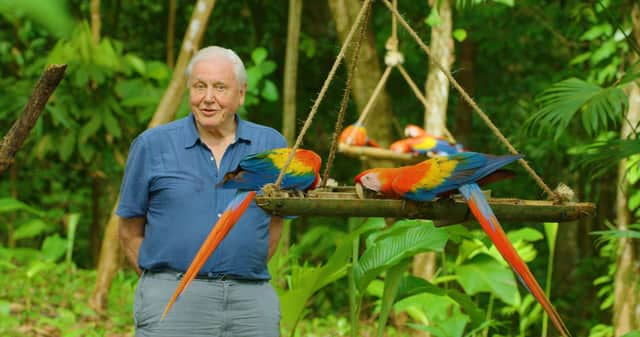Attenborough returns with Life in Colour


(BBC One, 7pm)
Just when you thought there was no aspect of the animal kingdom left for Sir David Attenborough to cover, the veteran broadcaster pulls a rabbit out of the hat.
Or in this case, a baboon, hummingbird, a Cuban painted snail, Bengal tiger, fiddler crab, and a whole host of other eye-catching creatures.
Advertisement
Hide AdAdvertisement
Hide AdAttenborough has always been fascinated by colour in the natural world – and series producer Sharmila Choudhury couldn’t wait to find out more about his lesser-known interest.
“We only discovered Sir David’s secret passion for colours in animals by chance,” she says. “He first wanted to make a series about colour in the 1950s, but at the time had to settle on one about animal patterns in black and white, because there was no colour television as yet. When we went to see him with the idea for this series, his excitement was unmistakeable. He dashed to his bookshelf and pulled out a book from the 1970s entitled Animals and their Colours and for the next hour we discussed the many glorious creatures we might feature and new stories there were to tell.”
This new two-part series marks the first time the BBC and Netflix have teamed up to make a natural history documentary, and it sees Attenborough explore the importance of colour in the natural world, travelling from the rainforests of Costa Rica to the snowclad Scottish Highlands.
“Animals of all kinds use colour in a multitude of different ways,” the broadcaster who turns 95 in May, explains. “New discoveries are giving us fresh insights into the lives of these animals and new cameras are allowing us to see into a world of colour as never before. We’re only just beginning to understand the many ways in which animals use colour, particularly those colours we can’t even see. For us colour in the natural world is a source of beauty, of wonder, but for animals, it’s a tool for survival.”
Advertisement
Hide AdAdvertisement
Hide AdInnovative camera technologies – some developed especially for this series – allow viewers to see the world as animals do for the first time, and reveal colours and patterns usually invisible to our eyes.
From the bold and brilliant, to the deceptive and bizarre, Attenborough’s Life in Colour is a visual feast that will surprise, enchant and dazzle the senses.
In tonight’s opening part entitled Seeing in Colour, we find out how, millions of years ago, the first animals had eyes that were unable to distinguish colour.
Gradually, however, this changed and ‘seeing in colour’ gave animals many advantages, whether to find food, attract a mate or warn off an enemy.
Advertisement
Hide AdAdvertisement
Hide AdThe Peacock’s magnificent tail, six feet long and with 150 dazzling eyespots has evolved entirely to impress the females.
The cumbersome tail feathers make flying difficult, but for the males it is worth it – the brighter his colours and the greater the number of eyespots, the more attractive he is to the females.
Meanwhile, mandrill baboons are one of the biggest and most colourful of all monkeys, and they signal their strength and status with colour – striking red and blue face masks.
Costa’s hummingbirds live in the vast deserts of North America, where bright colours can attract unwanted attention.
Advertisement
Hide AdAdvertisement
Hide AdSo the male only unfurls his spectacular headdress for the female’s eyes during a mesmerising display.
The magnificent bird-of-paradise has taken colour display to an extreme, while the blue-moon butterfly doesn’t appear very colourful to our eyes, but with a newly designed ultra-violet camera, his wings take on a magical look.
Fiddler crabs can see polarised light in a way that we can’t, and against the polarised mudflats, the crabs stand out better, so it’s easier for them to detect potential mates or rivals.
Andean flamingos get their pink colour from the food they eat, and only the pinkest birds can join in the spectacular mating dance.
Advertisement
Hide AdAdvertisement
Hide AdAnd finally, the strawberry poison dart frog, not much bigger than a fingernail, is one of the deadliest creatures in the rainforest – and his bright colours warn of his poison.
Predators know to avoid him, but the frogs also use their colours to attract a mate and to fight off rivals.